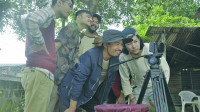Entertainment
Watching The Last Honey Hunter
The film is a unique effort that truthfully portrays a part of an oft-storied Nepal that no-one, not even Nepalis, really get to see
Sophia L Pandé
Everyone knows that it’s difficult to make a documentary, but the people who made The Last Honey Hunter will be able to tell you just how difficult it is to shoot in one of the remotest regions of the world—up in the hills with no direct road access, lugging bags full of fragile equipment to a small village in eastern Nepal that has never seen the likes of drones and Go-Pro cameras, much less a bunch of tough pros who know what it takes to get the crucial shots, and are determined to get it no matter the weather, the altitude, or stinging, infuriated bees.
The Last Honey Hunter is a film about Maulidhan Rai, a not so young man who has had a symbol-laced dream that allows him tacit permission to climb high into the cliff faces to harvest the hallucinogenic, medicinal honey that is then traded inside and outside of Nepal, making the livings of several pockets of men in the village and the larger Saadi community.
From the very first shots, while introducing the setting and the main character, the 35-odd-minute-long documentary sets a rhythm of its own with a particular, poetic, observational feel that continues throughout the film, making this an artful documentary. The film is more a sensitive portrait of a man and his village’s hopes and dreams, refusing to follow the adventurist vein that seems to be ubiquitous across media, unfortunately set in motion and perpetuated by the love of the thrill rather than on the actual, more interesting stories behind the thrill-seekers.
The Kulung, living in the Saddi community in the remote Hongu Valley, have longed believed in Rongkemi, a god-like spirit that is in the rocks, the air, the water, and the spirit of the animals around them. This animistic worship dictates the lives of the Kulung, and of Maulidhan, whose ambivalence about his honey hunting, despite his emblematic dream, is the dramatic crux of the film—even as the harrowing scenes of the man and his helpers dangling from the cliffs while harangued by furious stinging bees, might seem, to those who have not yet viewed this deeply humanist film, like they might steal the show.
Maulidhan and those around him take pride in their place in the honey harvest, but it is Dhan’s sense that he has somehow been punished for the thousands of bees and their larvae he destroys while harvesting that grips the viewer as we see the visceral violence inherent in beating at the bees’ precious nest hidden high up in the cliffs, away from the predators who would steal their golden honey from them.
Deeply observational, the film is beautifully shot by Renan Ozturk and Ben Knight. Knight who directed the film, also edited it in a thoughtful, unusual manner that relies on the use of recurring imagery to keep the viewer within the symbolic world of the film. The sheer, breathtaking cinematography is perhaps the most surprising fact about such a documentary that feels, in the end, more ethnographic than anything else—showing, without forcing, the lives of the people it documents.
As we listen to the candid interviews, and the deeply detailed shots of the Saddi community and valley, we begin to know the people that the film seeks to capture, in a way that less patient film-makers would certainly have botched, hurrying things along to the supposedly climactic honey harvest. Instead, in this film, we wait, never impatient, as the people and the process unfurl in front of us.
Produced with stoicism and passion by Ben Ayers, who has worked in Nepal for 18 years, and has been the Nepal Country Director of the dZi Foundation since 2006, the The Last Honey Hunter is a unique (hopefully there will be more) effort that truthfully portrays a part of an oft storied Nepal that no-one, not even Nepalis, really get to see.
As such, this is a heroic effort, one that requires skill, perseverance, and a deep knowledge of and commitment to Nepal. Perhaps this is the reason why it won the Audience Choice Award last month at Nepal’s very own annual Kathmandu International Film Festival (KIMFF) where it opened the festival and was greeted with a most enthusiastic response catalysed by the presence of Maulidhan himself and the other cast members.
The film is still on the festival circuit, where it has won numerous accolades, but will soon become available via streaming or on Netflix. Watch out for it, it is not to be missed.




 19.12°C Kathmandu
19.12°C Kathmandu










